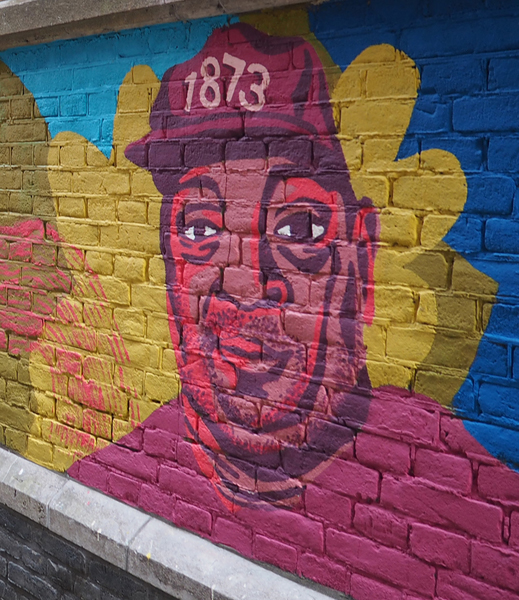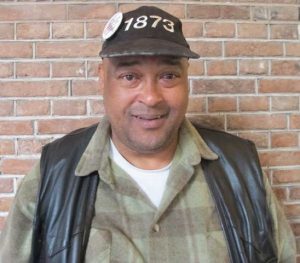A blog about (hidden) Amsterdam
A blog about (hidden) Amsterdam
“The Wall of Surinamese and Black Heroes” is a beautiful mural by Hedy Tijn & Dewy “Butterfingaz” Elsinga at the entrance to the Black Archives at the Hugo Olijfveldhuis. We want everyone to know their stories. Up next is the creative force for untold stories, Perez Jong Loy.

Perez Jong Loy was described by many who knew him as their uncle or their rock. He was also a genius at drawing attention to people and history that were being ignored. He was the driving force behind events that changed Amsterdam’s perception of itself and its history. His legacy is also an inspiration for how creativity can change minds.
“The pain of moving through a totally white world and not knowing where your home is, that is unimaginably common.[1]”
Perez Jong Loy’s family moved from Suriname to Amsterdam when he was a child. Later in life, he described it as a challenging time, with other kids picking on him or threatening him. He learned early in life to advocate for himself and his community. In 1975, the 21-year-old was kicked out of school for protesting the history department’s silence on Suriname, an omission made more shocking given that Suriname’s upcoming independence made it a constant topic in that year’s news.
That year also saw the debut of what became the internationally renowned Kwaku Festival. It began as a football tournament in the Bijlmer neighborhood, which by that point had a large Surinamese population. Perez helped with organization as Kwaku continued to grow into a joyous weeks-long celebration of food, music, sports, literature and ideas. It developed around the Netherlands’ Surinamese community but expanded to welcome other Afro-Caribbean cultures.
“For 400 years, African people have lived here and contributed to the economy.[2]”
In 2002, a grave was discovered in the Sephardic cemetery in Oudekerk aan de Amstel. The Amsterdam suburb has been home to a Jewish cemetery since the 17th century due to the restriction of non-Christians from burial within the city. The gravestone that was discovered in 2002 was from 1629 and it read “the good servant Elieser”, and the burial register described him as a black man in service to the de Pina family. Perez described being struck both by what this man must have felt and how many others he represented.
Perez helped organize the Day of Elieser. A statue by a Surinamese artist was erected outside the gates of the cemetery. On the last Wednesday in June, people gather around the statue for a memorial to Elieser and the mostly anonymous Black men and women who worked in Golden Age Amsterdam.
“I’ve made a vow, a sweri, with myself. I will continue to push this story until it hits the wider public.[3]”
In 2011, when organizers were planning the upcoming 150th anniversary of the end of Dutch slavery, Perez discovered a surprising fact: slavery didn’t end in 1863. While the law banning slavery went into effect in 1863, formerly enslaved people were forced to work on the plantations for another ten years. Plantation owners paid the workers terrifyingly low wages and no longer allowed them food from the plantations. The state oversaw this system and forbade workers from leaving. It wasn’t until 1873 that formerly enslaved people were actually freed.

Perez was shocked that not only had he never learned this in school, but the teenagers in his home hadn’t learned it in their school either. He designed a campaign that was startling in its simplicity. He designed a black cap with white numbers: 1873. There was little money for the project, so he decided to make the caps an exclusive gift, with only 25 being made. He printed 500 buttons with the same design that he would use to raise the focus.
For several years, June had begun with an eye-catching event. Memre Waka, a parade through the canal belt, ended with a wreath-laying at the Mayor’s house. This was to mark the impact of slavery on the economic life of the city as many houses in the Golden Bend, including the Mayor’s house, were built by slaveowners. Perez added something new to the ceremony; the mayor was presented with one of the 1873 buttons. The ceremony continues to this day, although 2020’s ceremony was virtual due to the pandemic.
“You never hear about the darker children who are bullied with this…[4]”
In 2013, Perez was part of a group of Amsterdam residents who filed a suit against an event permit. They were trying a new way to end Zwarte Piet, a blackface Christmas character from a Dutch book that was written during the time of minstrel shows and the debate about ending slavery. Filing the suit allowed Perez and his fellow Amsterdammers to speak honestly to the greater Dutch public about the impact of the character. It is still a bitterly contentious issue in the Netherlands today, but the suit had a large impact on the conversation.
When Perez passed away in 2019, social media and news sites were flooded with remembrances of a warm and witty man who was his community’s support and surrogate uncle, one who had a creative genius for sparking conversational change.
We hope you’ll join us someday on our Hidden Gems Tour, where you can learn about more incredible people like Perez Jong Loy.
[1]In these quotes, I’ve tried to translate his imagery, rather than literal word-for-word translations. “De pijn om hier in rond te moeten lopen in een totaal witte wereld en niet te weten ook aan welke kant jouw huis ook ligt, dat is onvoorstelbaar gewoon.” https://www.nhnieuws.nl/nieuws/187627/eerste-slaaf-in-nederland-ligt-begraven-in-ouderkerk-aan-de-amstel-peres-jong-loy-organiseert-al-zeven-jaar-de-dag-van-elieser
[2] “…hier al 400 jaar Afrikaanse mensen leven en bijdragen aan de economie.” https://www.nhnieuws.nl/nieuws/187627/eerste-slaaf-in-nederland-ligt-begraven-in-ouderkerk-aan-de-amstel-peres-jong-loy-organiseert-al-zeven-jaar-de-dag-van-elieser
[3] “Ik heb een afspraak, een sweri, met mezelf gemaakt. Ik ga hiermee door totdat het bij het grote publiek post vat.” https://hart.amsterdam/nl/page/31290/1873
[4] “hoor je mensen nooit over donkere kinderen die ermee worden gepest” https://www.rtlnieuws.nl/node/1522666
Check out some more Blamsterdam! posts.
Private Museum Tour
See the highlights and hidden icons of Amsterdam’s world-renowned Rijksmuseum in a private guided tour that explores who creates art and what stories it’s used to tell. And don’t worry about museum tickets. We’ve got you covered.


Small-Group Walking Tour
This historical tour through the busy Jewish quarter and residential Plantage neighborhood offers a selection of stories from BIPOC, LGBTQ+, Jewish and women’s history. It’s the perfect way to get an alternative view of Amsterdam.


Self-Guided Digital Tour
Use your phone to explore Amsterdam! This self-guided tour uses audio, images, maps, and text to introduce you to the women, BIPOC, LGBTQ+, and Jewish people who made Amsterdam what it is.


Small-Group Walking Tour
In 1593, Jewish Amsterdammers began building a community in the relative safety of the city that transformed both the Netherlands and the world. Learn about these creative, compassionate, and challenging mavericks and their impact.


Small-Group Walking Tour
The women who shaped Amsterdam are more complex than traditional tours would have you believe. Go to Amsterdam’s historic sites to hear stories of women who fought, wrote, calculated and led through the city’s chaotic and complicated past.


Small-Group Walking Tour
The world’s first gay marriage was officiated by the Mayor of Amsterdam at its City Hall. But did you know that the city’s LGBTQ+ history stretches centuries? Meet historical Amsterdammers across the gender spectrum and sexual orientations.


Private Walking Tour
Get a personalized tour that covers the interests you’re curious about and the neighborhoods you want to see. Choose pick-up/drop-off locations, any combination of our hidden history topics, and themes such as artists, politicians, and rebels.

